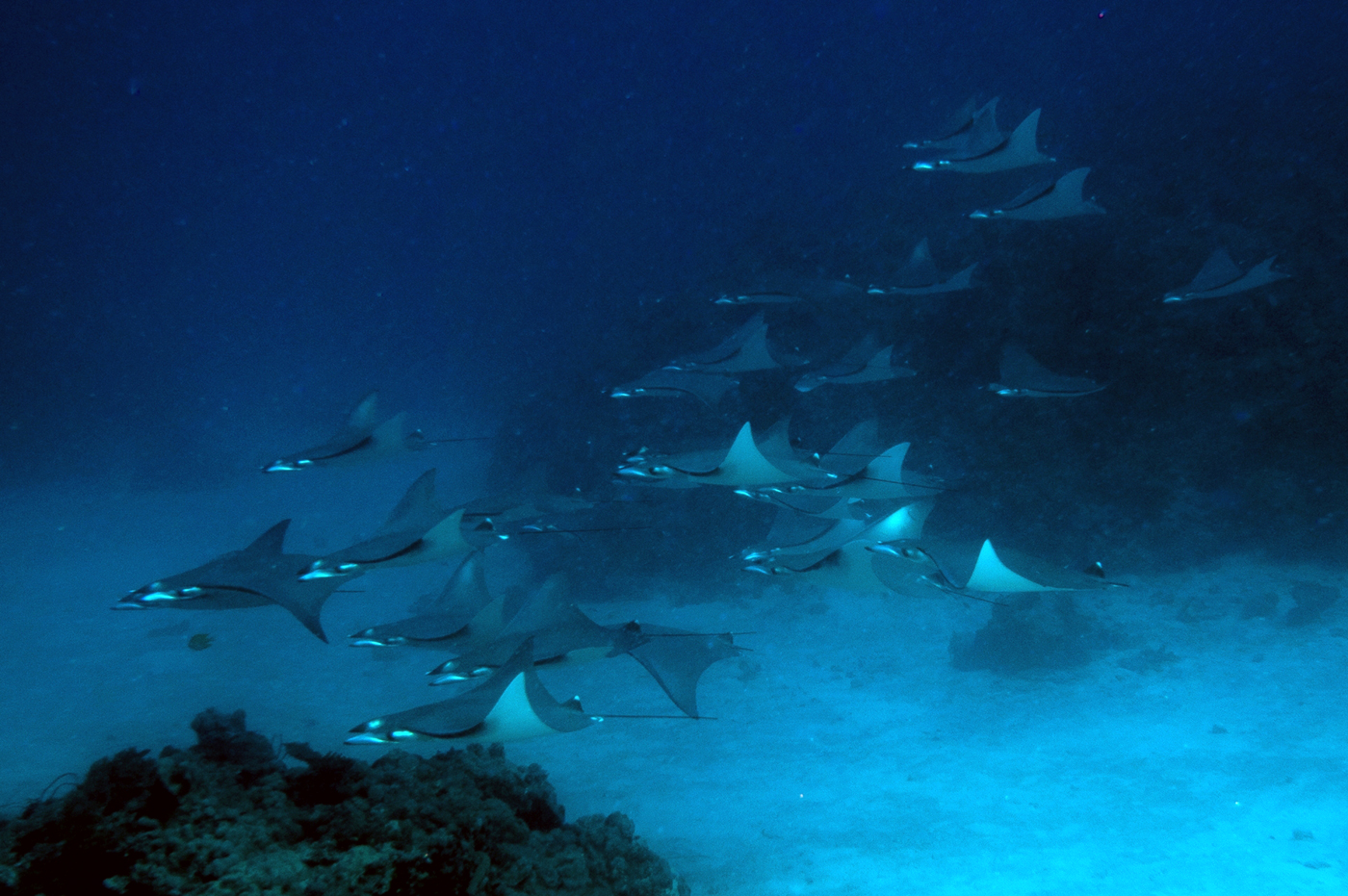Bentfin Devilray, Mobula thurstoni (Lloyd 1908)
Other Names: Lesser Devil Ray, Smoothtail Devil Ray, Smoothtail Mobula, Thurston's Devil Ray

Bentfin Devilrays, Mobula thurstonion the outer Great Barrier Reef, Queensland, August 2017. Source: mattytestoni / iNaturalist.org. License: CC by Attribution-NonCommercial
Summary:
A bluish-black devilray with an almost white underside with a narrow black margin, a white tip to the dorsal fin, a dark blotch on the underside of the anterior edge of the pectoral fin, and silvery pectoral-fin tips. The front margin of the pectoral fin has a prominent double bend, and the black disc margin on the underside becomes very broad at the concavity.
Cite this page as:
Bray, D.J. 2021, Mobula thurstoni in Fishes of Australia, accessed 10 Jul 2025, https://fishesofaustralia.net.au/home/species/3499
Bentfin Devilray, Mobula thurstoni (Lloyd 1908)
More Info
|
Distribution |
Off Ningaloo Reef, Western Australia, and the Great Barrier Reef, Queensland; also Cocos (Keeling) Islands and Christmas Island in the eastern Indian Ocean. Elsewhere the Bentfin Devilray is known from scattered locations in the Indian, Pacific and Atlantic Oceans. Individuals or groups inhabit coastal and oceanic waters. The species occurs seasonally occurs along coastlines with regular upwelling, off oceanic island groups, and near offshore pinnacles and seamounts. |
|
Colour |
Bluish-black with purplish tinge above; blackish margin along anterior disc becoming broad and very distinctive at level of concavity; dorsal fin with a distinct white tip (becoming faint in adults); ventral surface mostly white. |
|
Feeding |
Feeds mostly on pelagic crustaceans such as euphausid and mysid shrimps. |
|
Biology |
Females mature at 150–163 cm DW, and males at 150–158 cm DW. The species is aplacental viviparous - embryos initially obtain nutrients from the yolk, then absorb enriched uterine fluid provided by the mother. Females produce a single large pup (rarely two) born at 65-85 cm DW after a gestation period of about one year. |
|
Fisheries |
Targeted or taken as bycatch in pelagic and demersal gillnets, and purse seines in parts of its range - particularly in South Asia. The Bentfin Devilray is used for its meat, skin, cartilage, liver oil, and gill plates. The meat from mobulid rays, including the Bentfin Devilray, is often used locally or traded regionally for human consumption, animal feed, and shark bait. The cartilage, the skin, which is commonly used for leather products (shoes, wallets, and knife handles), and the gill plates are exported to Asia. The gill plates in particular fetch high prices in Asia and are used for in Chinese traditional medicine. |
|
Etymology |
The species is named in honour of Edgar Thurston, superintendent of the Government Museum, Madras, India, who provided Lloyd the opportunity to examine specimens from the museum’s collection. |
|
Species Citation |
Dicerobatis thurstoni Lloyd, 1908, Rec. Indian Mus. 2(2): 179, pl. 4(2). Type locality: India. |
|
Author |
Bray, D.J. 2021 |
|
Resources |
Bentfin Devilray, Mobula thurstoni (Lloyd 1908)
References
Couturier, L.I.E., Marshall, A.D., Jaine, F.R.A., Kashiwagi, T., Pierce, S.J., Townsend, K.A., Weeks, S.J., Bennet, M.B. & Richardson, A.J. 2012. Biology, ecology and conservation of the Mobulidae. Journal of Fish Biology 80: 1075-1119.
Last, P.R. & Stevens, J.D. 2009. Sharks and Rays of Australia. Collingwood : CSIRO Publishing Australia 2, 550 pp.
Lloyd, R.E. 1908. On two new species of eagle-rays (Myliobatidae), with notes on the skull of the genus Ceratoptera. Records of the Indian Museum 2(2): 175-180.
Marshall, A., Barreto, R., Bigman, J.S., Carlson, J., Fernando, D., Fordham, S., Francis, M.P., Herman, K., Jabado, R.W., Liu, K.M., Pardo, S.A., Rigby, C.L., Romanov, E., Smith, W.D. & Walls, R.H.L. 2019. Mobula thurstoni. The IUCN Red List of Threatened Species 2019: e.T60200A124451622. https://dx.doi.org/10.2305/IUCN.UK.2019-3.RLTS.T60200A124451622.en. Downloaded on 18 May 2021.
O'Malley, M.P., Townsend, K.A., Hilton, P., Heinrichs, S. & Stewart, J.D. 2017. Characterization of the trade in manta and devil ray gill plates in China and South-east Asia through trader surveys. Aquatic Conservation: Marine and Freshwater Ecosystems 27(2): 394-413, https://doi.org/10.1002/aqc.2670




